Motorola T6YH1 Manual
APPLICANT: MOTOROLA INC. |
FCC ID: IHDT6YH1 |
EXHIBIT 15
Instruction Manual
Exhibit Summary:
This mobile station transceiver is based on the design of a European GSM model. The user functionality and features are nearly identical to that GSM model. The user instruction manual that is included in this submission is a version of the manual for that GSM model. If necessary, a final version, as updated for this product and intended for the North American market, can be provided upon request.
EXHIBIT 15

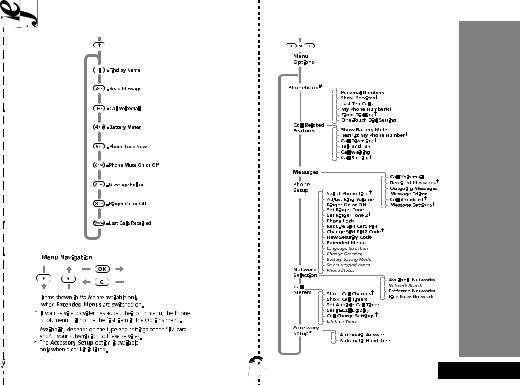
Quick Access Menu |
Options Menu |
# English
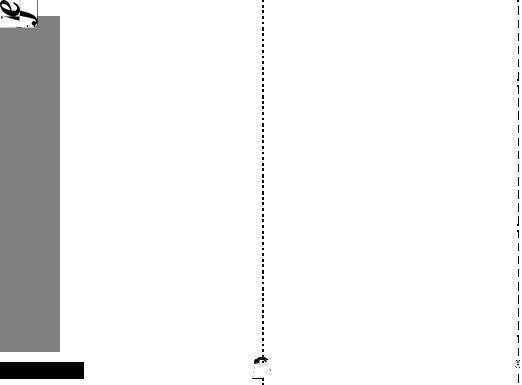
Special Keys
SPress and hold to turn the phone on; press to turn the phone off.
OPress to accept call, accept setting, accept option.
CPress to reject call, reject setting, clear digits, reject option.
[] Press to move through the menu and feature choices, or to edit an SMS message.
\Press to adjust the speaker or ringer volume.
Making a Call
Enter the number using the digit keys and press O.
Receiving a Call
To receive a phone call, press Oor any other key except Sor C.
Ending a Call
To end a phone call, press O.
GSM Emergency Calls
To dial the GSM emergency number, press 112O. The call will be directed to a central emergency operator.
Redialling the Last Number Called
When in standby mode, press OO.
Dialling Phone Book Numbers
To dial a specific Phone Book Number, dial
Location #O
One-Touch Dialling
Press and hold the appropriate digit key 1to 9.
Locking the Keypad
Press *and #simultaneously.
Quick Access Features
Press Efollowed by the appropriate key (1-9) or press E, scroll to the feature and press Oto select.
English
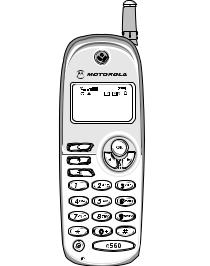
Introduction
Congratulations on your purchase of a cellular telephone from Motorola, the world leader in cellular technology.
All Motorola cellular telephones are manufactured to exacting specifications and world-class quality standards, and are designed to withstand the harshest environmental conditions. Our commitment to Total Customer Satisfaction and over sixty five years of experience in personal communications mean you can depend upon the quality of this Motorola product.
This cellular telephone has been designed for use with networks conforming to the GSM900 standard (Global System for Mobile communications). By using digital communications methods, your phone provides a number of advantages over traditional cellular systems:
•Superior speech quality is attained without the usual background noises and interference.
•Your conversation may be encrypted for security. Conversations cannot be eavesdropped using scanning equipment when the signal is encrypted.
•You are not restricted to using your phone within one country.
Your subscriber number is not contained within the phone as with other systems. Instead, a 'Smart Card' known as a SIM (Subscriber Identity Module) is supplied by your Cellular Service Provider. All call billing is made to the subscriber number on the card whether it is used in this or any other GSM 900 unit.
Introduction 1 |
English |
|
|
Understanding this Manual
Many of your phone options are accessed by a simple menu system. A full description of the menus and how to move around them is covered in the later section Menu Navigation. When the manual describes the use of each menu item, it will be assumed that you are familiar with the menu system.
Key Presses
Key presses are represented in this manual using symbols so that you may locate and use the required sequence quickly. A sequence of key presses may be shown as follows:
10C
This means that you should press the 1key followed by the 0key and then the Ckey, in sequence, not simultaneously.
AThe key shapes represented in this manual may differ from the keys on your phone.
Entering Information
When you are requested to enter information, such as the number of the phone you wish to call, this is represented in bold type. For example:
Phone No. - enter the required telephone number.
PIN Code - enter your Personal Identification Number.
Unlock Code - enter your unlock code.
Location - enter the Phone Book location number.
Prompts and Messages
Your phone responds to key presses by displaying either easy to understand prompts that guide you to the next action, or simple messages confirming that your action is complete. Prompts and messages are represented in this manual in LCD style, for example:
Enter PIN or Completed.
Other Symbols
You will find the following symbols used throughout this manual:
AA Note contains additional information which is relevant to the feature/item.
!A Caution contains important additional information which is relevant to the efficient and/or safe usage of your phone.
English |
2 |
Introduction |
|
|
|
Total Customer Satisfaction
At Motorola, Total Customer Satisfaction is a top priority. If you have a question, a suggestion or a concern about your Motorola Cellular Phone, Motorola wants to hear from you.
Please contact the Motorola Cellular Response Centre by fax on: +44 (0) 131 458 6732, or use one of the local phone numbers in the following countries:
Austria |
0660 7246 |
Belgium |
0800 72 370 |
Denmark |
43 43 15 56 |
Egypt |
02 3411800 |
Eire |
01 402 6887 |
Finland |
0800 117 036 |
France |
0801 63 67 03 |
Germany |
0180 35050 |
Greece |
00800 441 28150 |
Italy |
02 696 333 16 |
Jordan |
06 863750 |
Kuwait |
484 2000 Ext 1177 |
Lebanon |
01 744156 |
Luxembourg |
0800 21 99 |
Netherlands |
0800 022 27 43 |
Norway |
22 55 10 04 |
Oman |
790925 |
Portugal |
01 318 0051 |
Qatar |
418999 |
Saudi Arabia |
01 2303294 |
South Africa |
0800 11 48 49 |
Spain |
902 100 077 |
Sweden |
08 445 1210 |
Switzerland |
0800 553 109 |
Turkey |
0212 2729090 |
UK |
0500 55 55 55 |
United Arab Emirates |
04 32 11 66 |
For e-mail queries contact: |
mcrc@ei.csg.mot.com |
For Internet queries contact: |
http://www.mot.com |
Motorola’s Warranty
Your Cellular Phone is warranted by Motorola to be of satisfactory quality, fit for its purpose and comply with applicable Motorola specifications for a period of twelve (12) months from the date you bought it (verified by reference to your proof of purchase).
This warranty does not apply if the phone has
1been mishandled, misused, wilfully damaged, neglected, improperly tested, repaired, altered or defaced in any way.
2a defect arising as a result of any failure to follow instructions either in the manual or product specification.
3a defect which has arisen from the use of non-
Motorola approved accessories or ancillary items attached to or in connection with the telephone.
This warranty does not affect your statutory rights as a consumer.
Introduction 3 |
English |
|
|
English |
4 |
Introduction |
|
|
|

Contents |
|
Safety |
|
Important information for the efficient and safe operation of your phone ................................................................................ |
7 |
About Your Phone, Battery and SIM Card |
|
Introduces your phone, explains how to charge and maintain batteries and explains about your SmartCard...................... |
11 |
Making and Receiving Phone Calls |
|
Explains how to adjust volume, how to call a number, how to redial and how to accept a call ............................................. |
15 |
Menu Navigation |
|
Explains how to access and use the phone’s menus .................................................................................................................... |
23 |
Using the Options Menu |
|
Provides an explanation of the Options Menu............................................................................................................................. |
25 |
Using the Quick Access Menu |
|
Provides an explanation of the Quick Access menu and how to use it ...................................................................................... |
43 |
Approved Accessories |
|
Details accessories available for use with your phone ................................................................................................................ |
45 |
What To Do If |
|
Helps you to solve any problems that may occur......................................................................................................................... |
47 |
Index |
|
A comprehensive index .................................................................................................................................................................. |
49 |
The Manufacturer reserves the right to make changes in technical and product specifications without prior notice.
Contents 5 |
English |
|
|
English |
6 |
Contents |
|
|
|

IMPORTANT
For the efficient and safe operation of your wireless handheld portable telephone, observe these guidelines.
Exposure To Radio Frequency Signals
Your wireless handheld portable telephone is a low power radio transmitter and receiver. When it is ON, it receives and also sends out radio frequency (RF) signals.
European and International agencies have set standards and recommendations for the protection of public exposure to RF electromagnetic energy.
•International Commission on Non-Ionizing Radiation Protection (ICNIRP) 1996
•Verband Deutscher Elektringenieure (VDE) DIN-0848
•Directives of the European Community, Directorate General V in Matters of Radio Frequency Electromagnetic Energy
•National Radiological Protection Board of the United Kingdom, GS 11, 1988
•American National Standards Institute (ANSI) IEEE.C95.1-1992
•National Council on Radiation Protection and Measurements (NCRP). Report 88
•Department of Health and Welfare Canada. Safety Code 6
These standards are based on extensive scientific review. For example, over 120 scientists, engineers and physicians from universities, government health agencies and industry reviewed the available body of research to develop the updated ANSI Standard.
The design of your phone complies with these standards when used normally.
Safety
Antenna Care
Use only the supplied or approved replacement antenna. Unauthorised antennas, modifications or attachments could damage the phone and may violate FCC regulations.
Phone Operation
Normal Position: Hold the phone as you would any other telephone with the antenna pointed up and over your shoulder.
Tips on Efficient Operation: For your phone to operate most efficiently:
•Extend your antenna fully.
•Do not touch the antenna unnecessarily when the phone is in use. Contact with the antenna affects call quality and may cause the phone to operate at a higher power level than otherwise needed.
Batteries
!All batteries can cause property damage, injury or burns if a conductive material such as jewellery, keys or beaded chains touches exposed terminals. The material may complete an electrical circuit and become quite hot. To protect against such unwanted current drain, exercise care in handling any charged battery, particularly when placing it inside your pocket, purse or other container with metal objects. When the battery is detached from the phone, your batteries are packed with a protective battery cover; please use this cover for storing your batteries when not in use.
Driving
Check the laws and regulations on the use of wireless telephones in the areas where you drive. Always obey them. Also, if using your phone while driving, please:
•give full attention to driving - driving safely is your first responsibility
•use hands-free operation, if available
•pull off the road and park before making or answering a call if driving conditions so require.
Safety 7 |
English |
|
|

Electronic Devices
Most modern electronic equipment is shielded from RF signals. However, certain electronic equipment may not be shielded against the RF signals from your wireless phone.
Pacemakers
The Health Industry Manufacturers Association recommends that a minimum separation of six (6”) inches be maintained between a handheld wireless phone and a pacemaker to avoid potential interference with the pacemaker. These recommendations are consistent with the independent research by and recommendations of Wireless Technology Research.
Persons with pacemakers:
•Should ALWAYS keep the phone more than six inches from their pacemaker when the phone is turned on.
•Should not carry the phone in a breast pocket.
•Should use the ear opposite the pacemaker to minimise the potential for interference.
If you have any reason to suspect that interference is taking place, turn your phone OFF immediately.
Hearing Aids
Some digital wireless phones may interfere with some hearing aids. In the event of such interference you may want to consult your hearing aid manufacturer to discuss alternatives.
Other Medical Devices
If you use any other personal medical device, consult the manufacturer of your device to determine if they are adequately shielded from external RF energy. Your physician may be able to assist you in obtaining this information.
Turn your phone OFF in health care facilities when any regulations posted in these areas instruct you to do so. Hospitals or health care facilities may be using equipment that could be sensitive to external RF energy.
Vehicles
RF signals may affect improperly installed or inadequately shielded electronic systems in motor vehicles. Check with the manufacturer or its representative regarding your vehicle. You should also consult the manufacturer of any equipment that has been added to your vehicle.
Posted Facilities
Turn your phone OFF in any facility where posted notices so require.
Aircraft
FCC regulations prohibit using your phone while in the air. Switch OFF your phone before boarding an aircraft.
Blasting Areas
To avoid interfering with blasting operations, turn your phone OFF when in a “blasting area” or in areas posted: “turn off two-way radio”. Obey all signs and instructions.
Potentially Explosive Atmospheres
Turn your phone OFF when in any area with a potentially explosive atmosphere and obey all signs and instructions. Sparks in such areas could cause an explosion or fire resulting in bodily injury or even death.
Areas with a potentially explosive atmosphere are often, but not always, clearly marked. They include fuelling areas such as petrol stations; below decks on boats; fuel or chemical transfer or storage facilities; vehicles using liquefied petroleum gas (such as propane or butane); areas where the air contains chemicals or particles, such as grain, dust, or metal powders; and any other area where you would normally be advised to turn off your vehicle engine.
For Vehicles Equipped with an Air Bag
An air bag inflates with great force. DO NOT place objects, including both installed or portable wireless equipment, in the area over the air bag or in the air bag deployment area. If in-vehicle wireless equipment is improperly installed and the air bag inflates, serious injury could result.
English |
8 |
Safety |
|
|
|
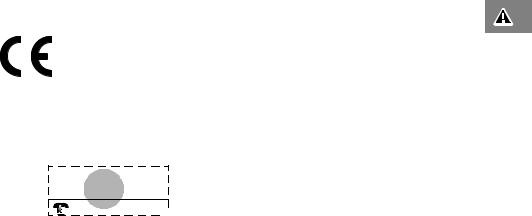
European Union Directives
Conformance Statement
This product is in conformance with the requirements of the applicable EU Council Directives.
Declarations of Conformance with the requirements are located at:
Motorola Ltd.
European Cellular Subscriber Division
Midpoint, Alençon Link
Basingstoke, Hampshire RG21 7PL
United Kingdom
APPROVED for connection to telecommunications systems specified in the instructions for use subject to the
conditions set out in them.
S/1357/4/V/503894
 "
"
Safety 9 |
English |
|
|

|
|
|
|
|
|
English |
10 Safety |
|
|
|
|
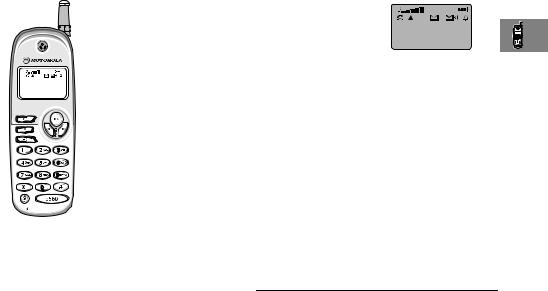
About Your Phone, Battery and SIM Card
The Keys |
The Display |
SPress and hold to turn the phone on; press to turn the phone off.
OPress to make and receive calls. Press to end calls.
Press to confirm the choice of menu or feature.
CPress and release to clear a digit in the display; press and hold to clear the entire display.
[ Press to move through the
]menu and feature choices, or to edit an SMS message.
EPress to access the Quick Access Menu features.
\Press to adjust the earpiece speaker volume. Release the key and hold it down again to change direction.
The display on your phone can show alphanumeric characters as well as useful information
symbols. The various elements of the display are as follows:
rx Signal Strength - indicates the strength of the coverage in your current cellular system area. The more bars lit, the better the chances of successfully making and receiving calls. Also indicates phone is switched on.
qBattery Charge Indicator. The more segments displayed, the greater the battery charge. Flashing indicates charging.
kIn Use. Displayed when a call is in progress.
lRoam. Displayed when you are registered on a Network other than your home Network.
oShort Message Service1- Displayed when the phone has received a message. The symbol will flash when your message storage area is full.
pVoicemail1- Displayed when your voicemail has received a message.
hRinger On. Displayed when the call ringer is selected. If you select the No Ring option this symbol will not be displayed.
1. Network and subscription dependent feature.
About Your Phone, Battery and SIM Card 11 |
English |
|
|
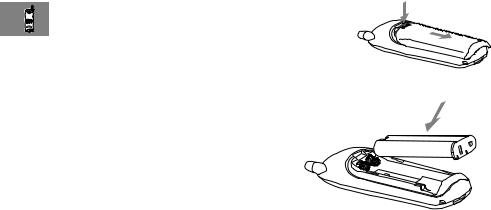
Your Battery
Batteries and Charging Information
To ensure that you enjoy maximum battery life and use your battery to its fullest capacity:
•Always use Motorola approved battery chargers.
•The battery should be at or near room temperature when charging.
•Once a week, allow your battery to discharge completely before recharging (to fully discharge, leave your phone on until it turns itself off).
!Do not leave the battery connected to any charger for longer than 24 hours.
AA new battery’s full performance is achieved only after two or three complete charge and discharge cycles.
•Best battery performance will be achieved when you regularly charge and discharge batteries as instructed.
•Battery performance is greatly affected by the coverage of the network.
•Keep the antenna fully extended whenever possible to ensure maximum signal strength.
•The performance of your batteries will gradually reduce if used substantially.
•If left unused, a fully charged battery will discharge itself in approximately one month.
•When not in use, store your battery uncharged in a cool, dark and dry place.
Removing the Battery Cover
Installing the Battery
AWhen re-inserting the battery, it can only be inserted one way with the black plastic ‘foot’ of the battery pointed to the left hand side.
English |
12 About Your Phone, Battery and SIM Card |
|
|
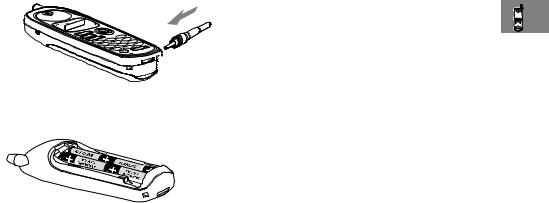
Charging the Battery
Insert the connector on the travel charger into the socket at the base of the phone and the plug into a suitable mains socket.
AThe battery door must be closed during charging.
* The phone can be either on or off during charging.
Using ‘AA’ Batteries
You can use Alkaline and Lithium 1.5 Volt AA Batteries in your phone. A different battery door is needed. This can be obtained from your dealer as an accessory.
!These batteries should not be used with Travel Chargers or Cigarette Lighter Adaptors.
Low Battery Warning
When the battery level is low and only a few minutes of talk time remain, a warning signal (two double beeps) will sound, and Low Battery will be displayed.
When the battery is completely discharged, your phone will turn off.
Battery Care and Storage
To prolong the life of your batteries, avoid exposing them to temperatures below -10°C (14°F) or above 45°C (113°F) . Never leave your phone or batteries in extreme temperatures (over 60°C (140°F)) , for example, behind glass in very hot, direct sunlight.
Battery Disposal
To dispose of batteries, check with your local recycling centre for a battery recycler near you. Never immerse batteries in water. Never dispose of batteries in fire.
About Your Phone, Battery and SIM Card 13 |
English |
|
|
